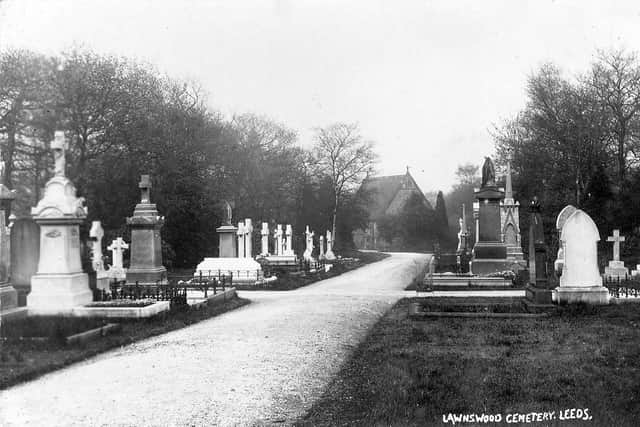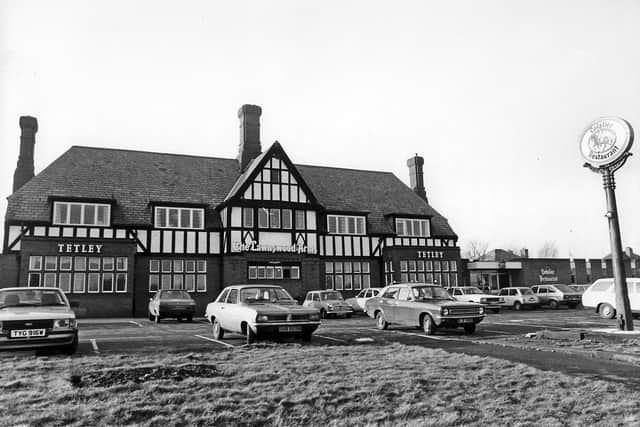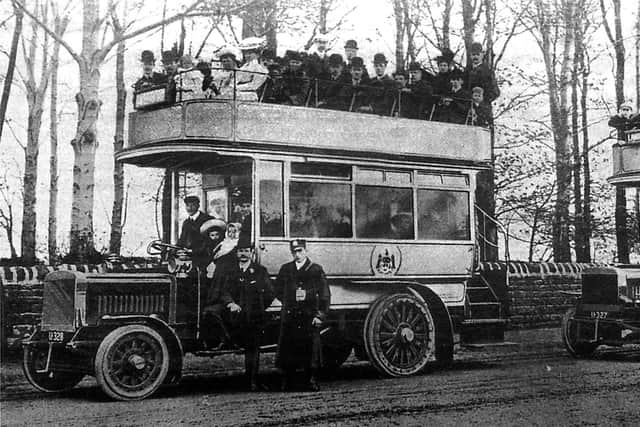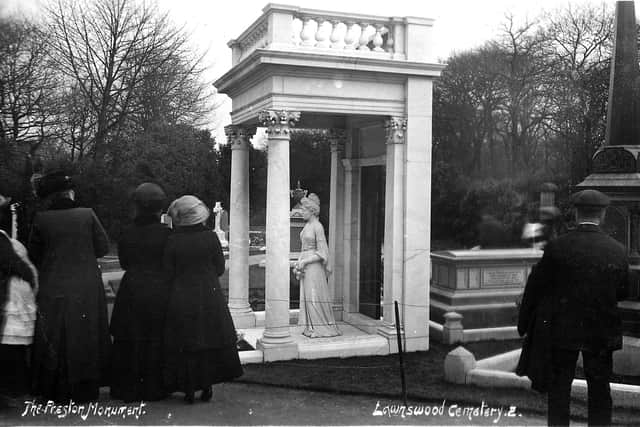Lawnswood Cemetery, Leeds: How life in Leeds sprang from the city’s dead centre
Lawnswood, north west of Leeds city centre, is an example, as it expanded alongside the opening of the cemetery in 1876.
The massive population increase in Leeds by the early 19th century caused a number of problems. Lack of space to bury the dead was one instance and upsetting stories were heard about the scandalous practices at Leeds parish churchyard.
Advertisement
Hide AdAdvertisement
Hide AdThen, in 1842, as pointed out by Steven Burt and Kevin Grady in The Illustrated History of Leeds (1994): ‘[Leeds] council was successful in obtaining the Leeds Burial Act which permitted it to levy rates for the purpose of internment of the dead.’ Following on, in 1845, was the opening of the Becket Street cemetery.


Twenty-nine years later, it was announced that plans had been selected for the Headingley and Burley burial grounds at Lawnswood.
The chosen design was by George Corson architect, Leeds. The chapels were to be placed at right angles to each other and connected by a cloister, with arches supported on pillars on each side.
On Tuesday December 21, 1875, the Bishop of Ripon consecrated ‘the church portion of a new cemetery’. William Gay was responsible for the landscaping at Lawnswood.
Advertisement
Hide AdAdvertisement
Hide AdThe ground covered 11 acres and was purchased at £200 per acre. Henry Sharp was the first to be buried in unconsecrated ground on January 23, 1876. The first internment in consecrated ground was in the following May.


At the end of October 1903, it was proposed to erect a crematorium at Lawnswood cemetery. During the previous ten years there had been on average 132 burials a year at Lawnswood, 74 in the consecrated and 58 in the unconsecrated part.
Some of the crematorium work was carried out by a French firm Toisoul Fradet et Cie. A report from January 5, 1905 said the first case of cremation to take place in the recently completed crematorium at Lawnswood occurred on the previous day.
The British Medical Journal of January 14, 1905 said at that time there were nine crematoriums in active existence in Great Britain. The oldest one – at Woking – was opened in 1885.
Advertisement
Hide AdAdvertisement
Hide AdLawnswood had to wait until the early 20th century for public transport to and from the area. The first Leeds municipal motor-bus began running from Headingley to Lawnswood on December 16, 1905.


The vehicle had a chassis supplied by the Rykneild Engine Company and a body built by the Leeds Tramway staff. Seating 38 passengers, it was capable of travelling at 15 mph.
Two years later, plans were in hand to extend the tramway lines from Far Headingley to Lawnswood but this took some time to complete due to drainage operations along the way. This didn’t stop speculation that when the extension was completed the City Council might consider funeral cars.
In many parts of America special funeral cars were run for the conveyance of the body and mourners to the burial ground. The tramway extension to Lawnswood opened for traffic on Friday April 18, 1913. It was said that ‘one effect of the extension, no doubt, will be to develop building ion the neighbourhood.’
Advertisement
Hide AdAdvertisement
Hide AdDuring the afternoon, October 5, 1910, a portion of the Lawnswood cemetery extension was consecrated by the Bishop of Knaresbrough. The new portion comprised about 11 acres, the same as the first portion. There had been 3,800 internments in the old ground. In the new ground there were 9,500 grave spaces, providing for around 50,000 internments. The cost of the extension, including paths, drainage, walls, entrance gates and the gardener’s lodge was about £5,000.


Excitement was caused at Lawnswood in 1913 with the erection of a monument on a grave. Known as the Preston memorial, it depicts a life-sized statue of Ethel Preston alongside a classical porch, with black marble panelled doors. He husband Walter, a chemist, erected the memorial after she died aged 50 in 1911. The monument cost around £1,000 and thousands of people had blocked the cemetery each Sunday to view it.
A spectacular memorial to businessman, Sam Wilson was erected at Lawnswood following his death in December 1918. The work was by E. Caldwell Spruce and one section shows a bronze angel holding a torch aloft mounted on top of a marble plinth.
In the 1930s there was much building activity in the Lawnswood area. Prince George arrived in Leeds on September 27, 1932 to open the new Leeds Modern School (for boys) and the Lawnswood High School (for girls), both grouped together at Lawnswood. They replaced the cramped quarters in the centre of the city where the activities of the Old Boy’s Modern and Girls’ Modern Schools were housed.
Advertisement
Hide AdAdvertisement
Hide AdThe site of the new schools covered some 26 acres of land. The two-storey buildings, in simple Georgian style, had accommodation for 600 boys and girls, and a central swimming pool was available for both schools.
Initially, Prince George went through the Girls’ school where it was said he devoted a good deal of attention to the domestic science department. The official opening ceremony took place in the hall of the Boys’ school.
On July 29, 1932, the dedication and opening of a columbarium took place at Lawnswood cemetery. The building was designed by Col. A.E. Kirk of Kirk & Tomlinson. The ceremony of dedication was performed by the Rev. F.H. Moore of Burley.
By October 1935, the Minister of Transport had made a grant towards a scheme where three separate streams of traffic would be accommodated on the Leeds-Otley Road near Lawnswood. In the centre would be a reservation for tramways, bordered by footpaths, and on either side would be a broad carriageway, one for north and the other for south bound traffic. The scheme was estimated to cost over £43,000 and would take around two years.
Advertisement
Hide AdAdvertisement
Hide AdA proposal for a zoo at Lawnswood emerged at the beginning of 1936. It aroused intense opposition among the residents of the district. Protesters said Lawnswood was rapidly being developed as a residential quarter and the majority of the houses were privately owned.
A.K. McKill, the promoter of the zoo, said there were no other zoological gardens nearer than Manchester, London and Edinburgh. Other features of the zoological gardens which would cover 44 acres of ground, included an ice rink, dance hall two ornamental lakes and a sports stadium.
But his application was turned down on January 14, 1936 by Leeds Town Planning and Improvements Committee.
Throughout the 1930s there were a number of housing developments at Lawnswood. One advertisement from early 1937, saw modern semis advertised at £575 and £675 on the Spen Bank Estate. They were ‘rustic brick built with red tiled roofs’. There was Vitrolite tiling to bathroom and room for a garage. A site could be secured for £5.
Advertisement
Hide AdAdvertisement
Hide AdIn 1937, magistrates granted the removal of the licence of the George IV in Woodhouse Lane, Leeds to land at the junction of Otley Road and Holt Lane Lawnswood to build a public house to be known as the Lawnswood Arms. The pub, built by J. Thomlinson & Sons of Globe Works Water Lane Leeds was open by January 1938.
During 1972, the Leeds Modern School for Boys merged with Lawnswood High School for Girls to form Lawnswood School. A year later, Lawnswood School became a comprehensive school. The buildings were demolished in 2003 and replaced by the current Lawnswood School.
Most properties in Lawnswood are large private detached and semi-detached suburban houses. Many, currently fetch some the highest prices in the City of Leeds.
The Friends of Lawnswood Cemetery, a small community organisation, was formed in 2011. Their aim is to enhance, protect and promote the cemetery for future generations.
Thanks to Leeds Libraries, Leeds Museums, the Thoresby Society and The Tramway Museum for help with this piece.
Comment Guidelines
National World encourages reader discussion on our stories. User feedback, insights and back-and-forth exchanges add a rich layer of context to reporting. Please review our Community Guidelines before commenting.